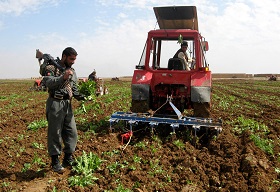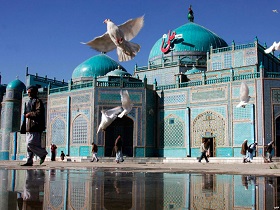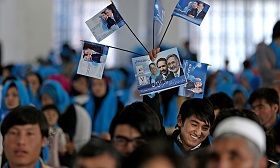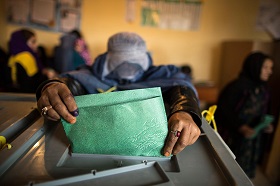The Political Crisis in Afghanistan and its Implications for Russia
Abdullah Abdullah andAshraf Ghani,
Kabul, July 12, 2014
In
Login if you are already registered
(votes: 1, rating: 5) |
(1 vote) |
Lead researcher and head of the Peace and Conflict Studies Unit at the Institute of World Economy and International Relations (IMEMO) in Moscow
The United States and NATO are withdrawing their forces from Afghanistan, leaving the country in a difficult, albeit not entirely hopeless situation. On the one hand, the armed conflict in the country rages on. Although its nature is changing, increasingly assuming the form of a confrontation between the insurgents and the Afghan armed forces and security structures, which are suffering record losses.
The United States and NATO are withdrawing their forces from Afghanistan, leaving the country in a difficult, albeit not entirely hopeless situation.
On the one hand, the armed conflict in the country rages on. Although its nature is changing, increasingly assuming the form of a confrontation between the insurgents and the Afghan armed forces and security structures, which are suffering record losses. The number of armed attacks and incidents grew by 15–20 per cent in 2013 alone. On the whole, the fighting today is substantially more intensive than it was before the Western intervention. Indeed, in the decade following 2001, Afghanistan joined Iraq and Pakistan as the three countries with the highest level of terrorist activity. According to the Global Terrorism Database, in 2012 these three countries accounted for more than half of all the terrorist attacks in the world and 58 per cent of all people killed in terrorist attacks.
On the other hand, in spite of all the alarmist scenarios that are common in Afghanistan, as well as inside and outside the region, a radical change of the balance of forces or overwhelming military superiority of one of the parties to the conflict after 2014 so far look unlikely, as does any real progress towards a peaceful settlement. Most probably the Taliban would only be willing to enter into serious internal peace negotiations after they “test the strength” of the Afghan army and government following the withdrawal of the bulk of Western forces. Thus, Afghanistan will likely experience a period of increased instability as the conflicting parties size up each other’s armed strength in the new situation. The central government and the national security structures will remain active, albeit on a limited scale. Hopefully, this will happen not only thanks to international support and the remaining Western military presence, but also due to the greater legitimacy of the new administration (compared with that of Hamid Karzai) as a result of the elections and further state building.
Until July 2014, this hope was fuelled by the successful experience of the presidential elections in Afghanistan (to the extent that they can be successful in Afghan conditions), which were held in spite of heightened internal conflict, the withdrawal of foreign troops and the schism that had formed between political elites. The first round on 5 April did not deliver an outright victory to any of the 12 candidates, but Dr. Abdullah Abdullah, former Foreign Minister of Afghanistan and at one time a prominent leader of the Northern Alliance, was leading with 45 per cent of the votes. His main rival, the former Finance Minister Ashraf Ghani Ahmadzai, a Pashtun, won 31 per cent of the votes (the Pashtun Zalmai Rassoul, who finished third with 11 per cent of the votes, eventually backed Abdullah Abdullah). However, the guarded optimism generated by the first round of elections proved to be short-lived and was erased by the events that unfolded after the second round on 14 June 2014.
The Crisis surrounding the Elections and Attempts to Settle it
The announcement of the preliminary results of the second round on 7 July 2014, which was won by Ashraf Ghani (who received 56.4 per cent of the votes, as opposed to first round favourite Abdullah Abdullah’s 43.6 per cent), dramatically exacerbated the situation in the country and triggered a full-scale political crisis. Both candidates immediately claimed victory. Abdullah Abdullah’s supporters took to the streets, and he himself made claims of massive vote rigging and ballot box stuffing (by as many as two million votes). Abdullah Abdullah recalled his observers from the electoral commissions and announced that he would form a parallel government.
On the one hand, large-scale vote rigging in this, like in any other election in Afghanistan (for example, in the previous presidential elections of 2009, when Abdullah Abdullah ran against the incumbent President Hamid Karzai), is more than likely, as it is the norm rather than an exception. It is even more probable in this case because the turnout announced by the election commission for the second round (8.1 million) was a dramatic increase from the first round (by more than a million). In some provinces – in Maidan Wardak, for example – the number of votes cast for Ashraf Ghani increased tenfold, and the turnout in rural areas was higher than in urban districts. The situation defies common sense and contradicts the numerous reports of a generally lower turnout than in the first round. Yet it hardly surprised anyone. The reason is that the incumbent president Hamid Karzai had committed his political and administrative resources largely (and in the second round entirely) to supporting the Pashtun candidate Ashraf Ghani.
On the other hand, all the main candidates in Afghanistan are guilty of serious violations and electoral fraud. We cannot rule out the possibility that Ashraf Ghani may have actually won the second round, even without all the ballot stuffing and in spite of his excessively pro-Western stance (even by Hamid Karzai’s standards) and his “track record”. In addition to the political support provided by Hamid Karzai (and tacit preference on the part of the United States), the fact that Ashraf Ghani appealed to the Pashtun majority may have played a part, as could his choice of Abdul-Rashid Dostum, the head of the Uzbek community and prominent leader of the former Northern Alliance – and one of the most opportunistic Afghan politicians – as his running mate.
Be that as it may, after the announcement of the disputed preliminary results of the second round, the split within the Afghan elites increased. Legitimate change of power in Afghanistan by relatively democratic means (i.e. in accordance with the universally recognized outcome of a general election) was brought to the brink of collapse. This happened against the backdrop of the government losing its (already tenuous) grip over certain regions, especially in remote rural communities, as well as active Taliban-led insurgency and the withdrawal of international NATO and U.S. forces. On the whole, the threat of failed national presidential elections and aggravated ethnic and territorial divisions may pose a more serious challenge to the future of Afghanistan than armed activities on the part of the Taliban.
The U.S. administration is keenly aware that bringing the political crisis in Afghanistan back into the constitutional realm is critically important. The Americans would like to be able to justify their withdrawal in the absence of a stable peace and security at least by way of a relatively effective political process. No wonder the United States, on the one hand, promptly admitted that there may have been serious irregularities in the second round and in vote counting, and on the other, threatened to cut off aid to Afghanistan if any unconstitutional bodies of power were formed. On 12 July 2014, the diplomatic efforts of Secretary of State Kerry and U.S. pressure on both sides brought about a temporary compromise, with the sides agreeing to a full centralized recount of the votes to be monitored by the United Nations and international observers, including the transfer of all the ballots to Kabul under the guard of the NATO and Afghan militaries.
The only credible way out of the crisis is through the creation of formal or informal agreements on power sharing between the main political forces in the country as part of a coalition government, reform and modernization of the political and electoral system and institutions.
Considering the gravity of the crisis and the United States’ weakened position in terms of the leverage it has over, and the pressure it can exert on, the country following President Obama’s announcement in May about the timeframe for the withdrawal of U.S. troops, it is not surprising that Jan Kubis, the Special Representative and Head of the United Nations Assistance Mission in Afghanistan, described the fragile compromise as a “miracle”. It is noteworthy, however, that the efforts to reach a compromise at this early stage were not confined to a feverish attempt to gain time, keeping the crisis at bay for at least the three weeks or more that it would take to recount the votes (naturally, the announcement of the final results and the inauguration of the new president would have to be postponed too). At a joint press conference with John Kerry at the UN office in Kabul, both candidates agreed to recognize the results of the vote recount and reaffirmed their pledge to sign a bilateral security agreement with the United States. The agreement sets the terms of the continued presence of U.S. forces in Afghanistan after 2014 and pave the way for the signing of an agreement on the status of the remaining NATO contingent. The two rivals publicly declared that whoever is declared victorious, they would be ready to form a coalition government of national unity including representatives of the losing side. The agreement stipulates that the new president will appoint the head of the executive branch – the runner-up in the presidential election.
Of course, there are many obstacles in the way of implementing the agreement (the vote recount was “suspended” due to a “misunderstanding” between the parties barely a week after the compromise was achieved). But in any eventuality (including the collapse of the 12 July 2014 agreement, with Hamid Karzai assuming special powers pending a new election or for an indefinite period, etc.) the only credible way out of the crisis is through the creation of formal or informal agreements on power sharing between the main political forces in the country as part of a coalition government, reform and modernization of the political and electoral system and institutions. This is particularly important in light of the parliamentary elections due to take place in 2015, after the main foreign forces are already out of the country – that is, probably in a still more complicated situation. It is particularly important to prevent any group, political force or community from gaining dominance because of the highly centralized form of government (which is very ineffectual for many reasons, but partly because it is overly centralized).
Russia’s Interests and Position

An Afghan policeman watches as a tractor
ploughs over poppy plants in Helmand Province
Before discussing what the current political crisis in Afghanistan means for Russia, it is worth recalling why Russia is worried about developments in Afghanistan in principle.
Moscow’s main concern is security. In particular, she is worried about two threats emanating from Afghanistan: the cross-border spread of instability, violence and extremism and the flow of Afghan narcotics into Russian territory. It has to be stressed that as the presence of U.S. and NATO forces in Afghanistan is drawing to a close in its present form, both these threats have increased to varying degrees and continue to grow.
While the spillover of instability and violence from Afghanistan directly threatens Central Asian countries most of all, including Russia’s CSTO allies, the production and trafficking of Afghan drugs, especially heroin, poses a direct and massive threat to the lives and health of Russian people. While in 2001, on the eve of the Western intervention, opium poppy crops in Afghanistan had shrunk by an unprecedented 91 per cent (as a result of an effective ban imposed by the Taliban on poppy growing), by 2013, at the peak of the foreign military presence, the area where the poppy crop is cultivated, according to the UN Office on Drugs and Crime, had increased 26 times to an historical high. The U.S. and NATO presence in Afghanistan did not set the explicit aim of reducing the production and trafficking of Afghan drugs. At the same time, the inability to offer solid economic alternatives at the macro- and micro-levels, the inefficiency of the Karzai administration and the Afghan authorities as a whole, and the escalation of the armed conflict contributed to the expansion of the opium economy. The completion of the withdrawal of the main U.S. and NATO forces by the end of 2014 will have a fundamental impact on the dynamic of the opium business, because it is accompanied by the retreat of government power and curtailment of development programmes in some regions, including the main drug-producing areas. That means even more opium and heroin in the coming years, including in Russia.
Moscow’s main concern is security. In particular, she is worried about two threats emanating from Afghanistan: the cross-border spread of instability, violence and extremism and the flow of Afghan narcotics into Russian territory.
Nevertheless, in terms of Russia’s immediate role, the main consequences of the withdrawal of U.S./NATO forces will not impact Afghanistan as much as it will Central Asia, where this role will only grow. Although the threat of armed violence spilling out of Afghanistan into Central Asian countries should not be overestimated, the threat is serious enough (especially for Tajikistan) to serve as a catalyst for the activities of Russia and the CSTO in Central Asia. Russia has already responded to this challenge by combining security and military aid with expanding economic aid and cooperation with partners in Central Asia.
As for the situation inside Afghanistan, Russia’s role and influence are limited and will remain so. No one, even Russia’s partners in the region, and nothing, even the colossal scale of the drug threat coming out of Afghanistan, can draw Russia into establishing a direct presence or taking part in security assistance inside Afghanistan after 2014. Therefore, on the issues that worry Russia most in regard to Afghanistan, Moscow will have to rely on the authorities that are established inside the country. That determines the key aspects of Russian policy on Afghanistan as a whole and its position on the political crisis in the summer of 2014 in particular.
First, Russia has never had such a compelling and sincere interest in seeing a more efficient and legitimate Afghan state than it has today. And what is more, this task – making state power more functional and legitimate – may serve as the lowest common denominator for all the regional players with regard to Afghanistan (in spite of the differences and contradictions among them and different ideas about how to tackle the problem). At the end of the day, this same task is the declared priority of the United States with regard to Afghanistan. Its importance for the United States will grow because the hasty withdrawal of troops (under a certain arbitrary “schedule” and not depending on the existence of conditions for such withdrawal) threatens to undermine American positions and influence in the region in the long term.

The shrine of Hazrat-e Ali, also called the
Blue Mosque, in Mazar-e Sharif, in northern
Afghanistan
Second, considering the weakness of the Afghan authorities (the government that will replace the Karzai administration is sure to be weak), Russia would like to see continued Western aid to Afghanistan in terms of security and development and even a continued residual presence of U.S. and NATO forces in that country. Such a presence is probably going to be based on a bilateral security agreement between the United States and Afghanistan, complemented by a corresponding agreement between Afghanistan and NATO, though Russia and most regional powers would prefer the agreement to be eventually formalized in the framework of the United Nations.
Third, after 2014, the problem of Afghanistan has become a powerful catalyst for developing and strengthening Russia’s cooperation with all the main regional players, including both its traditional partners (Iran, India) and (in the past) less likely partners (Pakistan).
Fourth, in the internal Afghan context, the policy of Russia, owing to its interest in seeing a more functional and legitimate Afghan state, is evolving in the right direction. Instead of priority support for certain ethnic and political factions and communities (notably Tajiks and Uzbeks), it is moving towards a more balanced approach that focuses on the national level, support of the central government and the Afghan state as a whole, and the development of relations with all the main factions and political forces.
As regards striking a balance on internal Afghan affairs, Russia is somewhere between Iran and China (both maintain working contacts with all the factions, but Iran is leaning more to the northerners, while China has more influence on the Pashtuns, partly through Pakistan). The pragmatic and balanced approach that emphasizes the national level is already bringing Russia some (admittedly modest) benefits: for example, the Afghan government was one of the few governments that de facto supported the reunification of Crimea with Russia. Moscow’s reluctance to side with any of the main candidates in the 2014 presidential elections reflects the increasingly balanced Russian approach to internal Afghan problems. Moreover, unofficially Moscow would welcome a coalition government and rule (for example, one of the two main contenders, be it Abdullah Abdullah or Ashraf Ghani, one as president and the other as prime minister).
Finally, Russia will have to seek – and find – a balance between supporting the process of national reconciliation in Afghanistan (Moscow is not opposed in principle to internal Afghan talks with the Taliban) on the one hand and calls for continued international aid to the Afghan national army and security bodies, including a readiness to strengthen them, on the other. Along with the settlement of the current political crisis, this is necessary to guarantee the viability of the central government in Afghanistan, to prevent a dramatic change in the military balance and retain some leverage with the rebels, which, depending on the outcome of the 2014 situation, would either push them to talk with Kabul or ensure their effective deterrence.
(votes: 1, rating: 5) |
(1 vote) |






